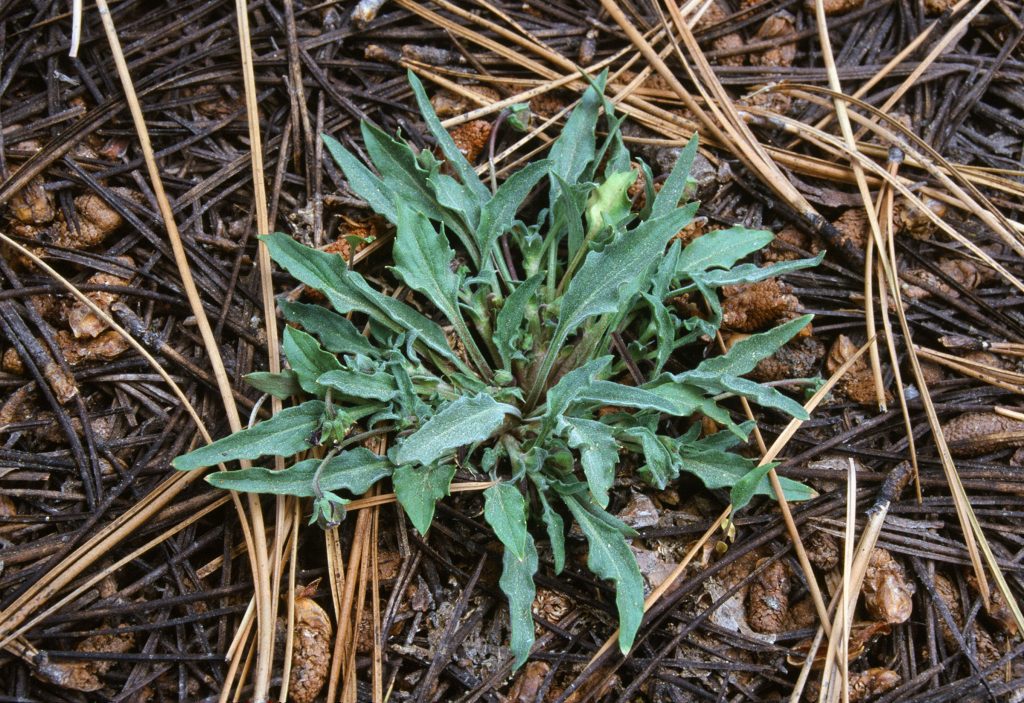Viola pinetorum Greene
Kim’s notes, unedited. Illustrations: 3 photographs of Viola pinetorum and 1 drawing.
Pittonia 2: 14. 1889.
TM (Thomas Marcussen) : Sect. Chamaemelanium subsect. Nuttallianae [New classification, 2010].
n=6, 2n =12
Edward Lee Greene, 1843-1915
‘Pinetorum’ means ‘of pines’.

SFO wildflower CD: Pine violet on Mines Road and in Mt. St. Helena area, SFO environs.
Range: California and Oregon to Northern New Mexico
See Abrams L. R. & R.S. Ferris. An Illustrated Flora of the Pacific States: Geraniaceae to Scropulariaceae, Vol. 3. 1951. Stanford University Press.

Harvey (Ballard) says that VV. aurea, pinetorum, quercetorum are all allopolyploids, therefore are all valid species. Allopolyploid= having two or more complete sets of chromosomes derived from different species.
From Jepson on-line:
- pinetorum Greene
Plant 4–22 cm, rosette-forming or not, glabrous to hairy
Stem prostrate to erect from woody taproot
Leaves simple, linear to ovate, generally ± toothed or wavy-margined; blade base tapered, tip acute; basal 4–20 cm, thin or not; cauline 30–150 mm, generally 4 X width
Inflorescence: peduncle 20–90 mm
Flower: lowest petal (including spur) 5–11 mm, lemon-yellow, lower 3 petals veined purple-brown, lateral 2 bearded, upper 2 ± purple-brown outside
Fruit 4–7 mm, puberulent
Chromosomes: n=6
Ecology: Dry places under shrubs or conifers to barren alpine rock
Elevation: 1400–3400 m.
Bioregional distribution: Cascade Range, Sierra Nevada, Western Transverse Ranges, San Bernardino Mountains, San Jacinto Mountains.Variable; needs study
subsp. grisea (Jeps.) R.J. Little

Plant 4–10 cm, canescent
Leaves 3–10 mm wide; basal 40–95 mm; cauline 30–80 mm
Inflorescence: peduncle < 70 mm. Dry mtn peaks and slopes
Ecology: Uncommon
Elevation: 1500–3400 m.
Bioregional distribution: s High Sierra Nevada [eastern half, Devils Postpile National Monument, Kings Canyon National Park, Sequoia National Park].
Synonyms: V. purpurea subsp. xerophyta M.S. Baker & J.C. Clausen in part

subsp. pinetorum
Plant 6–22 cm, glabrous to hairy
Leaves 4–25 mm wide; basal 50–200 mm; cauline 30–150 mm
Inflorescence: peduncle 30–90 mm
Ecology: Generally dry soil, often under pines
Elevation: 1400–3100 m.
Bioregional distribution: Cascade Range, Sierra Nevada, Western Transverse Ranges, San Bernardino Mountains, San Jacinto Mountains
Synonyms: V. purpurea subsp. mesophyta M.S. Baker & J.C. Clausen and subsp. xerophyta M.S. Baker & J. Clausen in part
V. pinetorum was found and photographed at approx. 8700-8,750 ft. Ask Phil Rundel what the pines were on top of Mt. Pinos. One was Limber, Pinus flexilis, but there were two others. Western Transverse Ranges, Kern Co., CA. Lemon yellow flowers with purple-brown lines on lower and typical brown-backed upper petals are small, less than half an inch, but proportional to the size of the plant. Gritty, granite soil with needle duff for organic matter, Jeffrey pine woodland.
From the 2000 catalogue of Ron Ratko: pines on Mt. Pinos mentioned in conjunction with Calochortus were, with C. venustus, the Jeffrey pine, Pinus jeffreyi, at 7,100’ and with C. invensutus at 8,800 ft. Pinus flexilis, Limber Pine. I saw both these calochortus further down the mountain than V. pinetorum.
Seeds from Ron Ratko, dull grey-brown speckled with black, 2.7 x 1.7mm.
From catalogue of Jim Archibald: Plumas Co. CA., Dixie Canyon, 1370 m. In a complex group of tap-rooted Californian endemics occurring sporadically from here south to the San Jacinto Mountains near Mexico. A plant of rather dry habitats, usually under pines, with tufts of narrow, more or less linear, wavy-edged leaves and lemon-yellow flowers with purple-brown veining and on the backs of the petals.
Smithsonian herbarium has isotype:
Viola pinetorum Greene, E.L., Pittonia 2:14. 1889 – Isotype (Violaceae)
COLLECTION: Greene, E.L. s.n., 25 Jun 1889. USA. California. Kern. Tehachapi.
VERIFICATION: Specimen compared to the original publication.
US SHEET NO.: 00007422 BAR CODE: 00114596
The photograph of the type specimen looks more like the plants I photographed out of flower further down Mt. Pinos, so this may not be a hybrid with aurea as I thought.
CalFlora: Jun 23, 2003, location about 9250 feet elevation, Bald Mountain Botanical Area, Sequoia National Forest (Tulare County, California)
Viola pinetorum Greene subsp. grisea ( Jeps. ) R.J.Little
Phytologia 72: 77. 1992 (nomenclatural synonym: Viola purpurea Kellogg var. grisea Jeps. Fl. Calif. 2: 521. 1936). Original [old] basionym: Viola purpurea Steven var. grisea (Jepson) [IPNI].
Willis Linn Jepson 1867-1946
Jul 1999, Viola pinetorum ssp. grisea, location Kern Plateau (Kern County, California), see copy of photo in this file, OR is this just V. pinetorum?? Or is the one I photographed ssp. grisea? Yes, maybe when I look at the location map for the counties of California most of the occurrences are further east especially towards the border with Nevada around Lake Tahoe. See plants.usda.gov for this info. Maps will not print out.
Viola pinetorum ssp. pinetorum only in the Alpine El Dorado, Fresno, Kern, Mariposa Nevada, Placer, Sierra, Tulare and Ventura counties, NOT in Inyo or San Bernardino counties.
Viola pinetorum ssp. grisea only in Fresno, Inyo, Kern, San Bernardino and Tulare counties.
Therefore, look for the latter, Viola pinetorum ssp. grisea in Inyo or San Bernardino counties, both on the eastern border of California.